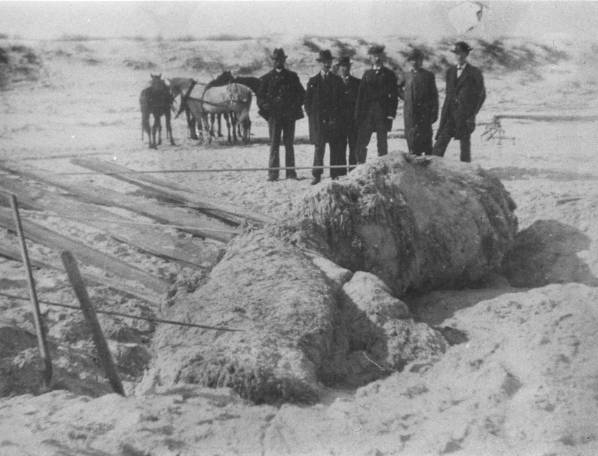Globsters: Mysterious Marine Monster Masses

What monsters may lurk deep in our oceans? We feel fairly safe on dry, familiar land, where dangerous animals can usually be seen and avoided. But since men first took to sea thousands of years ago, legends and stories have been told of fearsome marine monsters that awaited those who ventured too far from shore.
Mysterious creatures such as the kraken and the biblical Leviathan were said to attack sailors and drag them to their deaths. Though most of these monsters are mythological, science has found a basis for a few of the legends including the elusive giant squid, which can reach nearly 50 feet in length.
But what about other, more exotic sea monsters? Even though none have been found alive, some people believe they have been found dead — in the form of globsters. A globster is a huge, smelly mass of marine flesh found on beaches throughout the world. In his encyclopedic "Mysterious Creatures: A Guide to Cryptozoology," George M. Eberhart gives the following description of the typical globster: "No apparent bone structure; ivory-colored, rubbery, stringy, extremely tough skin; covered with fine hair or fiber; no defined head; no visible eyes."
Globsters are particularly intriguing, especially to laypeople, because they are mysterious and deformed. One classic globster washed ashore in 1896, when giant waves tossed a massive fleshy corpse on a beach at St. Augustine, Florida. The rubbery, 6-foot-high (1.8 meters) blob was examined by a local naturalist, who initially speculated that it was likely from a giant octopus. Many other globsters have washed ashore, including one in Chile in July 2003 and another in Newfoundland in 2001. Mystery has surrounded the creatures for decades.

Scientific analysis
So what are they? In a series of articles for his publication "The Cryptozoology Review," marine biologist Ben Roesch examined the original accounts of over two dozen globsters found between 1648 and 1924. He concluded that the creatures "often turn out to be basking sharks, whales, oarfish, or some other known creature." In other words, sea monsters might exist, but if they do, their dead bodies aren't washing up on beaches (unlike virtually every other known marine animal). [Related: Get Kraken: Why Scientists Should Study Sea Monsters]
A team of biologists led by Sidney Pierce published in the April 1995 issue of the journal Biological Bulletin noted that claims "are regularly made that the blobs are the remains of sea monsters. For example, the Tasmanian West Coast Monster is still referred to as a monster, although an Australian scientific team … identified it as a whale. Other relics such as the St. Augustine (Florida) Sea Monster and the Bermuda Blob are still described by some as the remains of a gigantic octopus, even though A.E. Verrill — who named the St. Augustine specimen sight unseen — recanted his identification in favor of whale remains … and in spite of microscopic and biochemical analyses showing that they were nothing more than the collagenous matrix of whale blubber."
Pierce and his colleagues confirmed that analysis in 2004, examining all available globster specimens using electron microscopes as well as molecular and DNA analysis. The conclusion: the samples were from various species of great whales. Thus, though often suggested as being mysterious or unknown, globsters have been identified as decomposed whale carcasses.
Sometimes a definitive scientific identification of a piece of animal flesh is simply not possible. Despite huge advances in DNA research, the results of a genetic test are only as good as the sample it is taken from. As with alleged Bigfoot samples, a result of "unidentified" or "unknown" does not mean that the animal it came from is unknown to modern science; it simply means that an identification was not possible from the samples available, which may have been contaminated or simply too degraded to yield reliable information. [Countdown: Our 10 Favorite Monsters]
Using science, one of the world's great mysteries of the sea has been explained. Globsters will of course continue to wash up on the world's beaches now and then, and they will still continue to make news as people marvel at the monstrous mass before them. Evidence of real sea monsters may be out there, but we haven't found it yet.
Benjamin Radford, M.Ed., is deputy editor of Skeptical Inquirer science magazine and author of seven books, including "Lake Monster Mysteries: Investigating the World's Most Elusive Creatures" and "Tracking the Chupacabra: The Vampire Beast in Fact, Fiction, and Folklore."
Sign up for the Live Science daily newsletter now
Get the world’s most fascinating discoveries delivered straight to your inbox.











